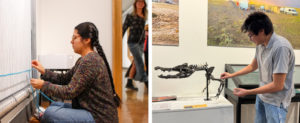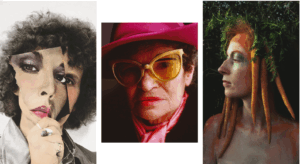
Internships give students professional insight
By: Michael Chesnick. February 27, 2024.Linda Garcia Escobar wants to be an art educator after growing up in a family of teachers and artists. Marcelino Flores hopes to expand his hobby of creating monster sculptures into a full-time venture, and he’s already showcasing his work at toy shows.
The two undergraduate students might have different career goals, but they share one thing in common: Both are glad they pursued local internships this semester through the University of Arizona School of Art.

Escobar, an Art & Visual Culture Education major, has written prompts and prepared weaving-themed activities for the University of Arizona Museum of Art (UAMA). Flores, a Studio Art major in 3D & Extended Media, has learned lab skills and how to present gallery work at GeoDecor Fossils & Minerals.
“Internships are important because they give you an insight into the work and career you want to pursue,” Escobar said. “Not only that, but I’ve been able to work alongside and learn from supportive professionals — and gain experience.”
One of those professionals is Chelsea Farrar, curator of community engagement at UAMA, who calls Escobar “amazing” and a “perfect match” for the museum. That’s because Escobar was beginning to explore textiles in her own artistic practice at the same time UAMA was opening an exhibition that included weavings by contemporary artist Marlowe Katoney, a School of Art alum. Escobar engaged visitors in the museum’s “Making Care: Drop-In Maker’s Space” with her textile activities and is documenting their responses and participation as part of her research.
“As a future art educator, Linda used the UAMA as a laboratory for experimentation, which brought novel ideas and art activities into our museum galleries and events,” Farrar said. “These activities have brought new visitors to our museum while engaging with them in ways we rarely see — they are staying in the museum for extended an extended period of time.”
As for Flores, he and fellow interns Isabella Way and Eliza Saunders helped install and present work at GeoDecor’s gallery during the recent Tucson Gem and Mineral Show, including fully mounted dinosaurs, a gigantic Eocene crocodile, woolly mammoth tusks, limestone murals with fossil fishes and palm fronds.
The three are also applying their artistic talents at the local company’s fossil lab, where they practice restoration techniques, preparation of newly discovered fossils and steel fabrication for the mounting of specimens.

“As a kid, you tell yourself one day I want to be an astronaut or a paleontologist,” Flores said. “So going into the fossil lab, I thought, oh my gosh, this is … not just a dream.”
By introducing paleontology to students, GeoDecor co-owner Christine Lindgren said interns also can expand their artistic capabilities through a mastery of 3-D printing; sculpting and color matching for fossil restoration; and commanding a diverse array of Dremel tools to free fossils from their matrices.
“We love having art students in the lab because they already come to us with a sense of precision, dexterity and a keen eye,” Lindgren said.
Other local internship possibilities
Over half the School of Art’s majors participate in internships before they graduate.
The nearby Center for Creative Photography holds an open house every August, where students from all majors can inquire about internship and student worker opportunities in areas such as archives, Digital imaging, learning and engagement and community engagement.
AVCE students Elizabeth Amphayvong (intern) and Jenna Green (graduate assistant), for instance, are part of the CCP’s Learning and Engagement team. Five other School of Art students also work at CCP: Branden Hale (PVI); and Grayson Agrella, Hannah Ramirez, Sco Scofield and Avery Johnson (Art History).
In recent years, other students have found internships on campus or with local organizations, non-profits and companies such as:
- African American Museum of Southern Arizona
- Arizona Historical Society
- Arizona State Museum
- Asthma & Airway Disease Research Center (UAHS)
- Ben’s Bells
- Coit Museum of Pharmacy and Health Sciences
- Darkroom at the School of Art
- Digital Print Studio at the School of Art
- Flandrau Science Center and Planetarium
- Laboratory of Tree-Ring Research
- LetterPress at the School of Art
- Mini Time Machine Museum of Miniatures
- Museum of Contemporary Art (MOCA)
- Museum of Optics, College of Optical Science
- Pay It Forward Tucson, Inc.
- Remember When … Photography
- Rialto Theatre
- Sculpture Tucson
- Silhouette Photography
- Sonoran Institute
- The Drawing Studio
- Tucson Museum of Art
- UA Biosphere 2
- UA Campus Health
- UA Campus Recreation
- UA Digital Humanities
- University of Arizona Athletics
- University of Arizona International
- Western Archaeological Conservation Center (WACC)
- Within Studio
Faculty members encourage students to talk to the school’s academic advising center about finding internship opportunities. Approved internships can qualify for academic credit.
“We often tell students that you can do anything with an art education and degree, and these internship opportunities are an excellent example,” said Professor Karen Zimmermann, associate school director. “Art students are good critical thinkers and problem solvers.”
As a result, School Director Colin Blakely said Art students who’ve honed their communication and creative problem-solving skills through internships are prime candidates for almost any job.
“We graduate lots of students that go into successful careers in the arts, in design, in education, in galleries, in museums. But we also graduate students that are incredibly successful in any number of other fields,” Blakely said, “whether it be entrepreneurship, whether it be law, whether it be business, whether it be even health sciences.”
Like Blakely, UAMA’s Farrar said she’s proud to watch School of Art students succeed after graduation.
“We’re so lucky to have had the chance to work with an incredible group of interns over the last few years,” Farrar said. “Many of them have been accepted to competitive graduate programs, while others are working in higher education, K-12 education or in other museums. … Knowing that we’re playing a role in the education of future generations of artists, educators and museum professionals is very rewarding.”
Get to know Linda Garcia Escobar
A senior who plans to graduate in fall 2024, she would like to pursue a career in teaching and consider graduate school. She transferred from Pima Community College after growing up outside of Los Angeles in Montebello, California.

“My uncle Oswaldo is an art teacher, so he always involved my sister and me in the arts,” Escobar said. “I grew up seeing his paintings and other sculptural work around the house and that’s mainly where my curiosity in the arts and painting came from. I wanted to make work like he did. When I finished school at Pima, I didn’t have a plan on what to do next so he along with my mom, who is also an educator, guided me into art education.”
Escobar’s art has been featured three shows, “The Place of Painting,” “The Undergrad Art Exhibition” and “Roots of Resilience.” In the latter, Escobar showcased her textile weavings.
“I have always been drawn to textiles for their colors and patterns, I grew up around amazing weavings from Guatemala and I had always wanted to explore and understand them,” Escobar said. “I like how repetitive the making process in textile work is, it is calming and meditative.”
Escobar praised School of Art Galleries Director lydia see for introducing her to weaving and UAMA’s Farrar and Willa Ahlschwede, assistant curator for Education and Public Programs, for their guidance.
“They are amazing educators and the most supportive and encouraging mentors I have ever had,” Escobar said. “Dr. Ryan Shin and Dr. Kate Collins (visiting professor) from the (AVCE) department are incredibly supportive and have always shown interest in the work I do outside of the classroom. (Faculty members) Alejandro Macias, Jonathan Marquis, Erin Digiovanni and Tioni Collins always offer to help and support my work as an artist.”
What student interns do at UAMA
Interns are directly involved with curating exhibitions, writing text for labels, or planning and facilitating our educational programs at the University of Arizona Museum of Art.
“Our interns work alongside staff in curation, education, registration and marketing, and it is often the first chance they have to understand how museums function,” Farrar said. “For the museum, it is such a beneficial opportunity for us to connect with students and have their voice be a part of our planning process.”
Farrar hopes students walk away having a bigger picture of what professional opportunities in museums might look like.
“And most importantly, I hope they leave feeling like their work at the museum matters and that they feel confident to enter the professional art world,” she said.
Get to know Marcelino Flores
Flores grew up in Tucson and started watching monster movies at a young age. He traveled 15 miles a day to attend Palo Verde High School because of its robotics team. The team, however, was canceled his junior year, so he started to focus on sculpture and his first love: Godzilla.

“I began sculpting in high school just to kill time,” Flores said. “With each piece, I would pour weeks and months of work into it.
“I felt challenged to capture the sense of incredible mass and awe of the giant creatures. Slowly this hobby grew into a future I want to invest all my time into.”
After graduation, Flores studies aerospace engineering at Pima Community College, but then COVID hit.
“I was like, man, studying math and physics and computer programming isn’t the same as sculpture,” Flores said. “So, I re-evaluated what I wanted to do,” and transferred to the College of Fine Arts at Arizona.
“I really like sculpting,” he said. “It’s an interesting journey, going from tech to art, but I’m happy, especially with the resurgence in Godzilla on television and movies.”
Flores is selling his Godzilla and other monster sculptures at toy conventions in Mesa, and he plans to attend the Tucson Comic Con again this September.
What student interns do at GeoDecor Fossil & Minerals
GeoDecor, which moved from Los Angeles to Tucson in 2010, is an internationally recognized fossil, mineral and meteorite company that works with interior designers, collectors and museums. The company began accepting interns from the School of Art this spring after Lindgren gave Zimmermann and Professor Kelly Leslie a tour of its lab last fall.
“I think it might be a big surprise to art students, to find out that there’s a whole field (in fossil restoration),” Lindgren said.
At the GeoDecor lab, on East 37th Street, interns work closely with her husband, Thomas E. Lindgren, co-owner of GeoDecor and a guest lecturer at the University of Arizona Department of Geosciences; Makoto Takigawa, the head fossil preparation artist; fossil technician Zach Durling, a recent University of Arizona College of Science graduate; and partner and 3-D printing specialist Jeff Parker.
Possible tasks for students include handling, moving and storage techniques; organization and maintenance techniques of the fossil lab; and lab skills such as preparation, restoration, mounting and exhibition techniques.
“Working as an intern here takes certain skills, like color matching and spatial aptitude,” said Takigawa, who received his BFA from the former San Francisco Art Institute. “It’s nice to have students with that kind of talent.”







